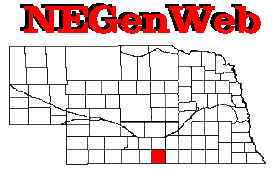

A HISTORY OF NAPONEE
by Barbara Bonham
Late in 1870 and early 1871, a settlement on Turkey Creek was established by a railroad comapny headed by Richard A. Walther and R.B. Werner who filed homestead claims where Naponee now stands. They were not, however, the first settlers in the vicinity. J.M. Ray had begun homesteading in the area in 1869. A Mr. Barney was also homesteading four miles northwest of the settlement. This settlement was at first called Perth and was located in the valley closer to the creek than the present site of Naponee.
With the arrival of these first settlers and their families, the need for a post office was felt and an application made and approved. George Roberts was appointed postmaster, and the office was named Naponee in honor of the home town of a Canadian who fought in the Civil War as a colonel and later bought land along the Repoublican River. As the town grew, it climbed the hill north and west of the original settlement.
NAPONEE -- FRANKLIN COUNTY
(By Dorothy Potter about 1990)
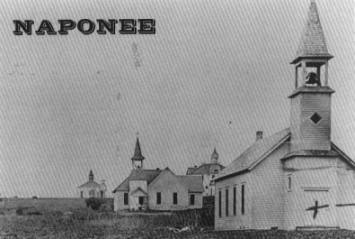 It's a
pretty place. The Republican
River winds its way southeast through gently-rolling hills and
borders the southern edge of the village of Naponee. Before white
settlement, buffalo, deer, elk and other wild game abounded, and
Indian villages dotted the landscape. Trappers were the first
to take up residency at this location, and a contingency of soldiers
were stationed in the area. Two of these soldiers, Pat Leonard
and Colin McRae, returned as settlers in 1871.
It's a
pretty place. The Republican
River winds its way southeast through gently-rolling hills and
borders the southern edge of the village of Naponee. Before white
settlement, buffalo, deer, elk and other wild game abounded, and
Indian villages dotted the landscape. Trappers were the first
to take up residency at this location, and a contingency of soldiers
were stationed in the area. Two of these soldiers, Pat Leonard
and Colin McRae, returned as settlers in 1871.
The following year Robert Dow arrived and wrote to his fiance, "All that is here is a post office in a dugout." He later wrote, "I have got a dugout stable built on my land, but I don't keep my horses in it. They have school in it on weekdays and church on Sundays."
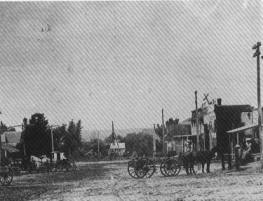 The
first settlement, "Perth"
was in the valley east of Turkey Creek. Later, people built on
the hill to the north, and called it "Naponee" in honor
of the hometown of a Canadian settler who fought in the Civil
War. Settlers had to travel 45 miles to Lowell for supplies, a
trip that took several days.
The
first settlement, "Perth"
was in the valley east of Turkey Creek. Later, people built on
the hill to the north, and called it "Naponee" in honor
of the hometown of a Canadian settler who fought in the Civil
War. Settlers had to travel 45 miles to Lowell for supplies, a
trip that took several days.
In the late 1800s the railroad established a depot in Perth. At
the peak of service, four trains were welcomed daily. Tom Moore's
dray wagon hauled supplies to local businesses.
By the turn of the century Naponee was a thriving community of about 200 people, surrounded by farms, with a busy main street lined with neat wooden business houses. Mail deliveries were made on foot and horseback, later with a two-wheel cart complete with wooden cab to protect the precious cargo. Mud, snow, or dust storms did not deter the regular delivery of mail. Nor does it in 1988, as the present carrier must also combat the weather that turns rural roads into bogs or almost impassable strips of ice and snow.
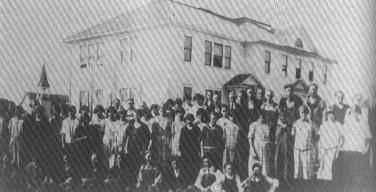 In
1909 Perth and Naponee incorporated
into one village and called their town Naponee. Telephone service
was also initiated. The operator not only directed calls but advertised
store sales and community events from the "central line."
In
1909 Perth and Naponee incorporated
into one village and called their town Naponee. Telephone service
was also initiated. The operator not only directed calls but advertised
store sales and community events from the "central line."
Soon four churches served the village. Presently there are
two active congregations, the Catholic and Wesleyan Church. An
eight-sided Congregational Church, one of only three such structures
in the country, now houses local artifacts and is maintained by
the Naponee Historical Society.
Turkey Creek, once the site of a flour mill with a capacity of
90 barrels a day, now provides a waterway border to the town park.
A 1906 news item states..."The Naponee Milling Co. billed
a carload of flour, Tuesday, to London, England."
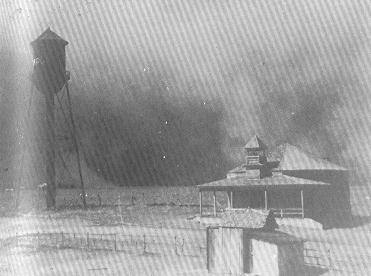 Naponee
enjoyed many successes,
but also its share of trouble. In 1874 grasshoppers roared in..."like
a heavy loaded train...turned the sky dark, and cleaned us out
in a hurry..." In 1920 a fire destroyed the Clampett Hotel
and adjoining buildings. The dust storms of the 1930s ravaged
the area, and powdery fine dust can still be found in the attics
of old structures. The 1935 "great flood" sent a ten-foot
high surge of water through the Republican River valley carrying
everything before it. Livestock, homes, and many lives were lost
in the tragedy.
Naponee
enjoyed many successes,
but also its share of trouble. In 1874 grasshoppers roared in..."like
a heavy loaded train...turned the sky dark, and cleaned us out
in a hurry..." In 1920 a fire destroyed the Clampett Hotel
and adjoining buildings. The dust storms of the 1930s ravaged
the area, and powdery fine dust can still be found in the attics
of old structures. The 1935 "great flood" sent a ten-foot
high surge of water through the Republican River valley carrying
everything before it. Livestock, homes, and many lives were lost
in the tragedy.
The building of the Harlan County Dam in the 1940s, four miles west, spurred a sudden growth in Naponee. The population grew to over 400 people and cafes stayed open 24 hours a day to accommodate dam workers.
The school that started in the dugout graduated to wooden structures and finally a two-story brick building. It closed in 1984 and students are currently educated in nearby Alma or Franklin.
While many small towns are dwindling, Naponee is a survivor. Main Street sustains a good number of businesses. An auditorium, built with volunteer labor in 1929, serves as a community hall. The population, listed as 160 in 1976, is making a slow but steady increase as families move from larger cities or other states to our town. New residents purchase homes as recreational get-aways or because they are employed in the area.
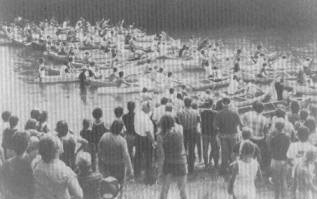 Naponee's
centennial year, 1976,
was a time to honor the past and herald the future. Prominently
situated four miles east of the Harlan County reservoir and bordered
by the Republican River, Naponee welcomes summer tourists. Each
July, canoe races attract nearly 200 participants and hundreds
of viewers. The proximity of the Republican River first drew settlers
to the area, and now as a recreation area, continues to be a prime
attraction for Naponee's future.
Naponee's
centennial year, 1976,
was a time to honor the past and herald the future. Prominently
situated four miles east of the Harlan County reservoir and bordered
by the Republican River, Naponee welcomes summer tourists. Each
July, canoe races attract nearly 200 participants and hundreds
of viewers. The proximity of the Republican River first drew settlers
to the area, and now as a recreation area, continues to be a prime
attraction for Naponee's future.
By Dorothy Potter, 301 Jefferson Street, Box 123, Naponee,
NE 68960
NAPONEE
From Andreas History of the State of Nebraska
This little town is pleasantly located on the west bank of Turkey Creek, in the Republican Valley, not far from the river. The creek affords an excellent water-power, which is utilized for mill purposes. The Burlington & Missouri River Railroad passes along the southern part of the town on the level lands. The business houses are mainly on two streets, one fronting toward the railroad, the other extending north and south, with the buildings fronting toward the creek. From each of these two streets, the surface of the land rises toward the northwest, forming a quite steep hillside.
Though there has been a town here but a few years, its history may be said to extend back to the time of the formation of a settlement here, late in the year 1870. At that time, Richard and A. Walther and Romeo B. Werner entered claims at and in the vicinity of where Naponee now stands. To this place they removed in the spring of 1871. This formed the nucleus of a large and prosperous settlement that was destined to spring up in a few years, and spread throughout the western part of the county.
In 1871, the settlement had progressed until the need of a post office was felt, and a petition was sent to the postal department at Washington, asking that a post office to be called Naponee be established at once. This name was chosen on account of a town in Canada by that name. The post office was soon established and George Roberts appointed Postmaster.
The first sermon preached here was by Rev. David Edgerton, in 1873.
The first school was taught in the summer of 1873 by Miss Rosa Schlegal, in a dug-out belonging to R. B. Werner.
The first marriage was that of James D. Gage and Miss Estella E. Douglas, which took place January 18, 1874.
A flouring mill was commenced here in 1874 by Walther & Gallard. It was located on Turkey Creek and on Section 4, Town 1 and Range 16 west. The next spring, however, before the mill was quite completed, the creek overflowed and washed out one side of the bank to such an extent that the mill fell over into the mill-race. This disaster proved so serious to the proprietors that they were soon obliged to dispose of the property. The mill was purchased by J. D. Gage, who has since continued to operate it, and a good quality of flour is manufactured.
There was another wash-out again in 1881, though not a great deal of damage was done to the mill property, other than the race. The flood carried off the top soil between the mill-race and the creek for a depth of about six feet, leaving a bed of hard-pan perfectly bare, into which was deeply impressed the footprints of buffalo and elk. Before this flood, ash trees twenty-five feet high covered the top soil.
The first store was opened here in 1877 by Calvin R. Dodd.
The first birth was that of Roy Cramer, which took place in January, 1877.
The first death was that of Oscar D. Gage, infant son of J. D. and Estella Gage, on the 13th day of April, 1877.
The first schoolhouse erected in the present town was one of sod, built in 1877.
CHURCHES.
The church organizations in Naponee are well represented. The Methodist Episcopal Church was organized September 17, 1876 by Rev. Mr. Van Duser, and consisted of six members, viz., T. G. Thomas and wife, Henry Fox, L. H. Fish, Wilson Hildreth and wife. The first pastor was Rev. Moses Mapes. The society in time increased to sixteen members, but now the old Methodist society has dwindled down to two members.
The Baptist Church was organized April 8, 1877, with nine members. Rev Thomas Muxlow was chosen as pastor and Charles H. Brown, Church Clerk. This church has now thirty-one members, with Rev. George O. Yeiser, of Red Cloud, as pastor, and J. F. Zediker, Church Clerk.
The Congregational Church was organized May 15, 1881, with seven members. Revs. William Marshall, J. W. Strong and W. S. Hampton were all present and assisted. Rev. William Marshall, of Alma, was chosen as pastor. The present membership is ten.
A union Sunday school here is in a good flourishing condition. Henry Fox is Superintendent.
In the winter of 1879-80, when the railroad was being built through this town, several additions to the town site were made, and the railroad company laid out a town on the east side of the creek, joining the old town site, which they called Perth. A depot was built here, and an effort was made to remove the town of Naponee here, but this was unsuccessful, and the railroad company soon resumed the old name of Naponee.
During the excitement just preceding, and during the time the railroad was in progress, Naponee grew rapidly and many business houses were established. A newspaper called the Banner was founded in 1879, by W. A. Connell, who afterward sold to J. F. Zediker, but he discontinued it in 1880, and the town soon began to go backward.
Naponee still enjoys the luxury of a sod schoolhouse. The town has been platted, but never incorporated. Owing to the short crops in this vicinity for the past two seasons, the town has been on a decline, having now a population of less than one hundred; but it has a very favorable location, a fine water-power and an extensive flouring-mill, and it seems that the day cannot be far distant when Naponee will be one of the prosperous towns of the Republican Valley.
BIOGRAPHICAL SKETCHES.
J. D. GAGE, proprietor of buhr-stone creamery, Naponee, born in Bethel, Vt., 1842; when six years of age his father died , and he accompanied his mother to Canada, where he resided for eleven years. He was the second man to enlist in the First New Hampshire Cavalry; served in the army of the Potomac under Gens. McClellan, Pope, Grant, Sheridan and others, and participated in all the general battles, from Bull Run to Five Forks; was taken prisoner and boarded on Belle Island for three months. From 1865 to 1867, was connected with the Quartermaster's Department in the valley of the James, and Harbor Master of the Port of Richmond until turned over to the civil authorities. During the years 1866 and 1867, was Superintendent of the U. S. Burial Corps at Richmond, and re-buried at that point, 1,300 Union soldiers, and 7,000 at Fort Harrison. He received a severe bayonet wound at the Rockets' riot December 18, 1865. Mr. G. enlisted in 1861, and was mustered out in 1867, serving in all six years and six months. In 1868, he went to Chicago, where he remained some time. Then farmed for several years in Guthrie County, Iowa. He then wended his way to Franklin County, Neb., and at once embarked in the stock business and milling, which he has followed since. He owns a half interest in the Naponee Mills. Mr. G. Served three years as a Commissioner of Franklin County, and two terms as President of the Agricultural Society. He was married in 1874, at Manchester, Iowa, to Miss Estella Douglass.
A. M. DECLERCQ, farmer and stock-raiser (Durham cattle and Poland-China hogs), Moline is a native of Cazenovia, N. Y., where he was reared on a farm. He came to Nebraska in March, 1874, took a homestead and timber claim of 160 acres each, and has since bought 160 acres. Has 300 acres under cultivation. Makes a specialty of breeding Short-Horn cattle, Poland-China hogs and Mambrino horses.
Naponee Historical Society has it's own web page too, come check it out!
Return to Franklin County NEGENWEB page HERE.
Page by PS Designs Updated 2008